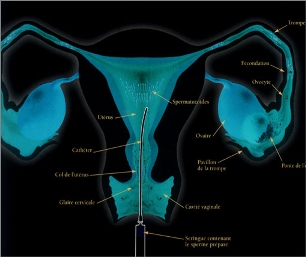Artificial Insemination is also called Intra-Uterine Insemination (IUI)
Procedure :
- IUI may be done in a natural cycle but usually the woman is given medication to stimulate the ovaries for development of multiple eggs and insemination is timed to coincide with ovulation.
- Semen sample is collected either at home or in the hospital after 2-5 days of abstinence.
- Semen is washed in the laboratory using either a gradient method or a swim up technique. This process is called sperm processing and takes about 30-40 minutes.
- About 0.4-0.5 ml of culture media is finally added to the washed sperms and the sample is ready for insemination.
- This washed sample is transferred to the uterus using a sterile flexible catheter.
- The procedure is not painful and the patient is sent home within half an hour.
- Unexplained infertility.
- Mild to moderate oligoasthenospermia (where sperms are slightly less in number or low in motility).
- Cervical factors.
- Problems with ovulation.
- Mild endometriosis.
Best results are seen when the age of the woman is not more than 35 years and infertility is not more than 4-5 years.
- Severe tubal damage or blocked tubes.
- Genital tuberculosis.
- Severe male factor.
- Women more than 40 years.
- Advanced stages of endometriosis.
1. Favorable
- Male factor with slightly reduced sperm count or motility.
- Age of the woman less than 35 years.
- No associated pathology like endometriosis or PCOD.
- Duration of infertility less than 5 years.
2. Unfavorable
- Age of the woman more than 40 years.
- Severe male infertility
- Defect in sperm morphology.
- Any degree of tubal damage or pelvic scarring.
- Previous history of genital tuberculosis.
How many attempts of IUI should be taken up?
The best results are seen within the first three attempts of IUI. In women with ovulation disorders, up to six attempts can be taken combined with ovulation induction. In case pregnancy does not happen, patients are re-counseled and IVF maybe undertaken.
IUID (Donor Insemination)
In case of absolute azoospermia, donor samples are used for insemination (all other conditions being the same as in IUI using husband’s sperms).
Only frozen samples are used which have been previously been tested for HIV, hepatitis and ABO and Rh group.
Instructions to the Male partner:
If using fresh semen, your partner should be available on the day of the insemination. It is recommended that he abstain from ejaculation 2 to 5 days before giving the semen sample. Two weeks following the IUI, a pregnancy test will be performed to determine if the treatment was successful.

